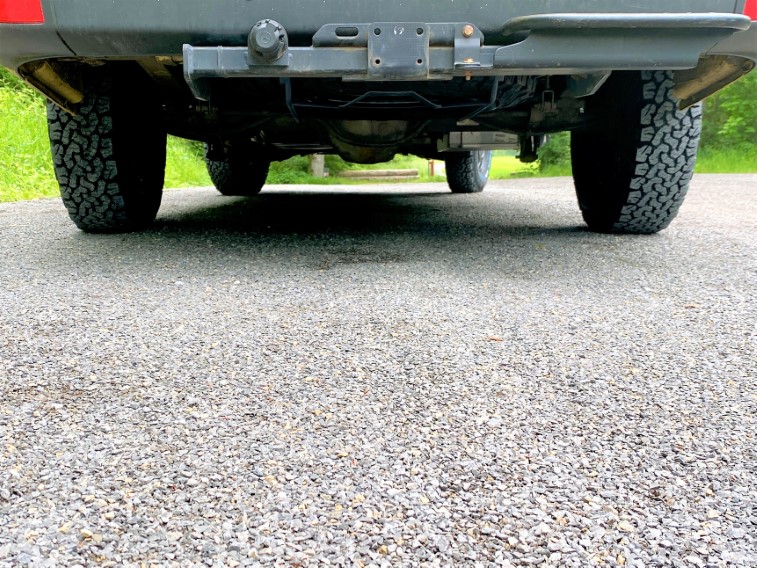Chassis Mods
We've following modifications at our Sprinter:
Wheels & Tires
Since the rear axle is a rigid axle only bigger wheels gives you more clearance.
Chosen dimension: 235/85R16 on steel rims (ET 54) which seems to be the maximum height for which you "might" get the car electronics adapted and especially TÜV. Overall it provides a lift of 47mm compare to the standard sized 235/65R16. But having an axle transmission ration of 4.182 with those tires induces also some drawbacks (see right side).
As tires I've went with BFGoodrich AT KO2*. I had them already on my other car and was happy with them. They are built for all types of terrain I'm heading for.
Why so small?
- I tried to stay within the regular track width. It's just not a comfortable ride if the Sprinter follows the large truck ruts if you have a broader track width.
- Plastic wheel covers tend to break or fall off. If the wheels end at the regular outer edge you don't need those and you skip that trouble.
- It's a standard NATO-format I should get everywhere. Same as the rims. With exotic sizes you might get troubles.
- Last but not least: I have more flexibility with a rather small tire but a high flank. On regular roads the inflated tire is part of the suspension concept and doesn't add much full consumption. On gravel roads I can just deflate a bit and the Sprinter drives more smoothly. But at the end, I have much more room to deflate the tire to extend the footprint quite significantly. If the tire is wide but not high, there is not much footprint change if you need it (sand, mud).
Bodylift I (for "Bodylift II" you've get to contact)
Diff-Lock
Shock absorbers (Just give Christian a call. He is very nice guy.)
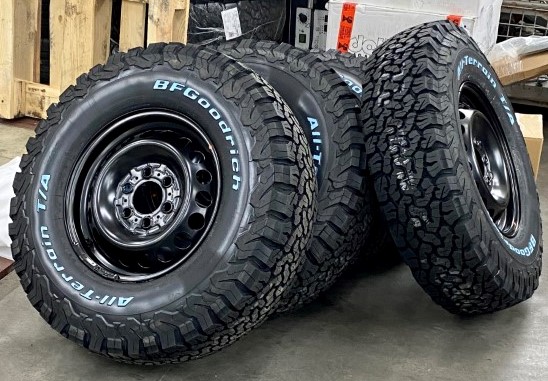
Body Lift
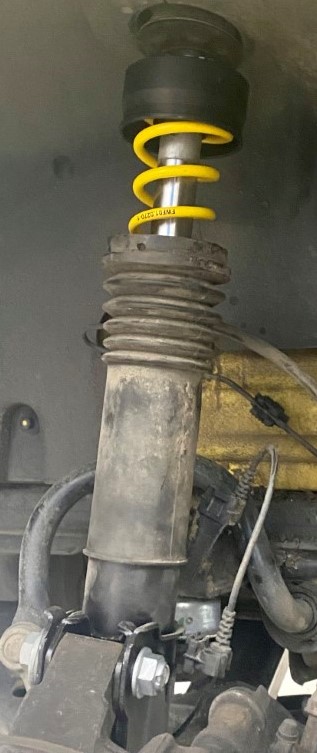
The Body lift kit(s) were planned to provide enough room for the wheels, but not much more. At the front it's Goldschmitt spring coils over shock absorbers and a stronger 5t front leaf spring. At the back it's simply an additional leaf spring. Overall it provides a lift of ca. 6-7 cm.
All the huge bodylifts don't really help, if you touch the ground with your axles long before. The clearance at the "tummy" was good, since I've decided already for the L2H2 which has a shorter wheel base. I had just to keep it with my conversion in mind to keep the tummy clear as possible. If you have a L3Hx more extrem bodylifts might help. BTW: springs are not much involved during dynamic suspension. At a ride the shock absorbers do this job.
The result is quite impressive. At the back I got in total just the lift from the wheels (+47mm). The clearance under the axle went from 17,5cm to a bit more than 22cm. On the front it was total game change due to the axle geometry and my bad starting point with the C15-Option (lowered front). It went from 15cm to 29cm under the gear shift box. So, overall it should be good for Island.
Differential Lock
Rear axle differential lock. Hard to find but will be the game changer "off"-road and/or in snow/ice... at least as long as I have one wheel on the ground on the back ;o)
Since in my setup I can activate a permament lock, both wheels at the rear axle will turn at the same torque, independent, if one might have lost grip.
Factory 4x4: the electronics first needs to recognize that a wheel lost grip to break this wheel to distribute the torque to the remaining wheels. In the meanwhile not a single wheel out of 4 will have any torque since all torque is wasted to the spinning wheel. The car simply stops moving while mine keeps moving (hopefully).
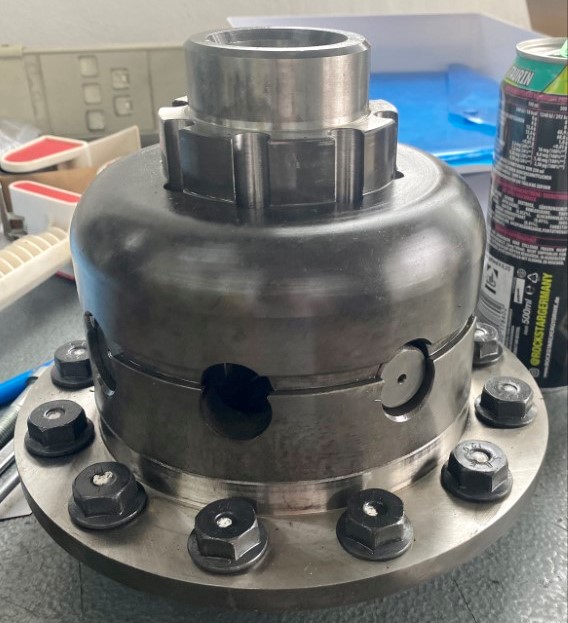
Shock Absorbers
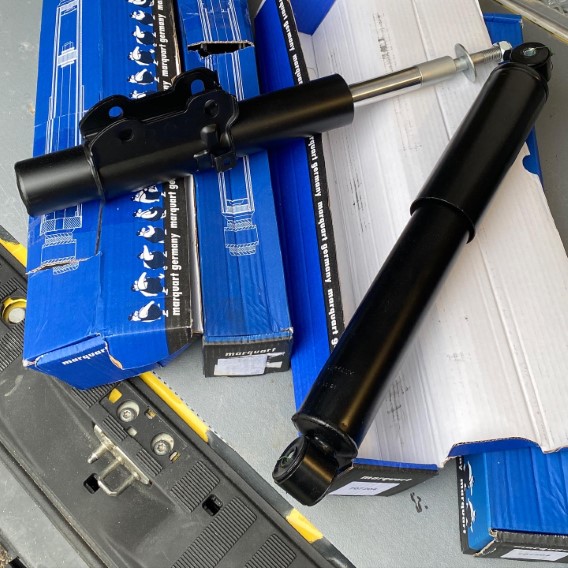
Marquart shock absorbers at all 4 wheels. On the front: Tuning Stage 1 (750402) with a 45mm lift kit (500001), back: HD tuning stage 3 (707204).
That modification was pretty important. Because every bodylift lifts the axles away from the connection point of the shock absorbers to the body, the standard shock aborbers (or any other OEM) will be simply too short to work in the optimum range. After some fantastic calls with Christian (Marquart) we quickly decided for some adopted shock absorbers of him. Those work not only at compression stage but also at attension. It really makes a huge difference!
Those became a huge game changer in terms of the driving performance. (If you're interessed, please see "Detailed Driving Observations" at the bottom.)
BTW: Marquart will ship broken shock absorbers worldwide within a day or two. And in emergency case, I can just use any OEM since it fits to the factory connection points.
Summary
In total I earned just a bit additional weight, but much more traction as a regular 4x2 and in certain situation even more than a factory 4x4. No extrem retrofit, and at a first glimpse a very discreet appearance. Perfect. Inner values... you know!
That's it. I'm so happy, since I have now a really "off"-road capable Sprinter, which drives like crazy in curves like a regular car (not as a shaky Sprinter anymore). Steady chassis even in stand. And I know, I may can get further then people might think - but at least to the point I trust the whole package or my own confidence or my passengers start to cry. Depends, what hits first ;o)
Short version: The combination is simply fantastic.
Onroad: From the driving feeling I no longer have a VAN, but rather a large passenger car. The Norwegian roads have partly asphalt with coarse grit. The suspension is very sensitive. I suspect that the first millimeters are absorbed by the tire (due to the high tire wall) and the rest is "smoothed out" by the shock absorbers. Transverse joints are audible, rather than palpable (and only if they hit both tires exactly at the same time). There is no swinging at all on partly quite wavy roads (could observe the difference very well with a Sprinter driving in front of me. It swings enormously and ours just not at all). The straight line driving is very nice. With 8 bft. wind from the side you notice of course the large car surface. But the car doesn't lean into the wind anymore but stays cleanly upright, so that I can easily make steering corrections with two fingers. Traffic circle passages, turns, rapid or tightening curves can be done smoothly without any problems. If you’re forced to leave the asphalt only at the edge certain concentration is necessary, then despite completely different surface and waviness it’s completely safe to handle. The tire works (contrary to possibly other experiences) even in rain and road flooding very controlled. Neither when braking nor when cornering I had adhesion problems. Due to the "narrow" tire, there were also hardly any problems with truck ruts on the highways
Off-road: as long as you stick to the motto "as fast as necessary", difficult passages can be mastered without making the passengers feel sick. The ground clearance is excellent and the “belly clearance” is perfectly adequate due to the normal wheelbase. The car doesn't really sing, but follows a virtually leveled ground course very well. Compression and rebound damping also seem to fit perfectly diagonally. If the car ever swings to one side, it stands upright without swinging in the opposite direction. Very cool.
Standing: Both the springs and the dampers result in a new, stable state even when standing. When someone stands up or turns at night, the car hardly swings at all. Susceptibility to wind is also minimized.
The overall package subjectively seemed a bit tight to me on the first few meters. But that was only the first impression. In fact, it results in a very sensitive response from the suspension, which then reacts progressively to increasing pressure. In fact, I'm pretty sure that these overall characteristics only got so good because of the combination of tire height and shocks complementing each other, and that the FA also has the new shocks (not just the RA as some make it). Anyway, I'm very happy. If you wanted to draw a comparison, the BMW 3 would still come to my mind the most. Far from spongy, also no longer so soft as a Mercedes in old days but also nowhere near as dry and nervous as a Z4. But with sufficient suspension travel for off-road use.
I can only recommend you to contact Christian Marquart personally to talk about the really good shock absorbers. In Germany it’s becoming a little insider tip for a much better Sprinter-driving. He probably also speaks excellent French & English, so that you will certainly understand each other well. If you get in contact – best greetings from Michael from Hamburg (the yellow Sprinter VAN).
Just to be clear: I didn’t get any sponsoring or anything else. I just wanted to share my personal experience with you. I learned so much from the community, so I only want to pay back something.
